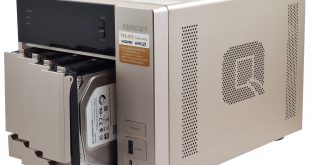
QNAP's latest TVS NAS series, the TVS-473 sits under the company's SMB midrange label and is available as four, six and eight-bay units. The TVS-473 is the 4-bay entry level model of the series; a 4-bay NAS that so packed full of features it can be used for just about any purpose.
For the TVS-*73 series, QNAP has joined forces with AMD so all three units in the range are powered by an AMD R-Series Quad-core SoC, an RX-421BD to be exact, which runs at 2.1 GHz (burst up to 3.4 GHz).
The RX-421BD is a compact 28nm SoC measuring just 37mm x 29mm with a 2MB L2 cache supporting DDR3-2133 or DDR4-2400 memory speeds. The main core provides a single PCI-e Gen 3 x8 or PCI-e Gen 2/3 x4 lane with support for up to three display outputs. The PCH on the chip itself offers SATA, SD Card, SPI, 4-8 USB 2.0 and 4 USB 3.0 ports connectivity. The integrated Radeon R7 graphic core has a maximum clock speed of 800MHz with 8 GPU Compute Units and 512 Shader cores. The RX-421BD has a TDP range between 12-35W.
The TVS-473 comes in three basic memory versions, all using DDR4-2133MHz; an entry-level 8GB model (TVS-473-8G), 16GB (TVS-473-16G) – the model QNAP sent for review, and the flagship 64GB unit (TVS-473-64G).
We mentioned the TVS-473 was packed full of features, well how about this for a list, deep breath; up to 64GB of DDR4 support, AES-NI hardware encryption engine, four, yes four LAN ports, two M.2 SATA SSD slots, SSD cache support, USB 3.1 (10Gbps), 10GbE expandability via one of the two PCI-e Gen 3.0 slots, dual HDMI output, not forgetting hardware-assisted 4K video decoding and encoding acceleration.
Specifications
AMD RX-421BD SoC.
Embedded AMD Radeon R7 Graphics.
Built in AES-NI hardware encryption engine
16GB memory.
Dual HDMI multimedia output (4K, 1080p).
2-year warranty.
The QNAP TVS-473-16G comes in a large brown box with a sticker on the front side which has an image of the NAS unit together with a fairly comprehensive spec table and AMD branding for the R series SoC and Radeon graphics.
The rear of the box has six small icons in the bottom left-hand corner displaying some of the uses the unit can be used for; Data Protection, Surveillance Station, Mobile Management, Private Cloud, File Sharing and Backup Station.
One side of the box has an HDD & SSD compatibility information panel at its base while at the top are transportation icons. The other side has a row of icons showing the standards that the unit complies with.
The box bundle consists of; two Ethernet cables, screws for mounting 2.5in drives in the drive trays (the TVS-473 supports both 2.5in HDD and SSD), mounts and screws for M.2 drives, QNAP RM-IR004 infra-red remote control, two AAA batteries for the remote and a quick start guide.
QNAP even supply a couple of heatsinks for any M.2 drives used in the TVS-473. Annoyingly however the one thing missing from the box bundle is what might be one of the most useful; a USB cable for the Quick Connect feature.
QNAP's TVS-473-16G is of a tower design with front, vertically mounted drive bays. The cover and chassis are constructed from a good quality metal and the unit is finished off in an attractive Champagne Gold colour. The front bezel is made from a decent plastic and also gold coloured.
The unit also features a large LCD screen above the drive bays, which displays set-up information when the NAS in powered up. The power button is placed on the right-hand side of the front bezel and under it sit the USB One-touch-Copy button and the USB QuickAccess port.
The drive bays use a simple latching system to open and close; There is no form of physical lock on the drive bay doors, something to think about if you are using the NAS in plain sight in a busy office with a lot of outside traffic.
The rear panel of the TVS-473-16G is about as complex as you will see on a “desktop” NAS design and it shows just what today's units are and the TVS-473-16 in particular, capable of supporting. The panel is dominated by the grill for the Y.S Tech FD121225LB 120mm cooling fan. To the side of the grill sit the majority of the I/O ports.
There are a pair of 4K HDMI 1.4b ports, three 3.5mm audio ports (two microphone and single audio), three USB 3.0 ports and four Gigabit Ethernet ports. At the top of the rear panel is the external access for the pair of PCIe Gen3 slots, one of which houses a 2 port USB 3.1 Type A add-in card.
The back panel also has a grill for the internal speaker. Ah yes, the speaker. This is a NAS that speaks to you!! I must admit it made me jump as I was unaware that it had this voice feature until (the volume was turned up) a loud woman's voice informed me that the NAS was being prepared to start.
The four drive trays are tool free, each using a pair of press in plastic retaining bars, the pins of which sit through the screw holes in the side of the tray and into the mounting holes in the side of a drive, a simple but effective design. The mounting holes also have grommets to aid in damping down drive vibration. The bottom of the trays have screw holes for mounting 2.5in drives.
Getting access to the four DDR4 SO-DIMM slots and the two M.2 SATA ports is as simple as undoing the three small screws in the rear of the unit that holds the outer cover on. Once the cover is off you are confronted by a lot more hardware than we would consider normal for a 4-bay NAS.
The motherboard for the TVS-473-16G is housed vertically one one side of the chassis. The first thing that you notice is the large cooler for the AMD SoC. It's an active cooler that uses an Evergreen T12601BU 60mm fan which is rated at 4,800RPM.
Next to the SoC are the four DDR4 SO-DIMM slots which are stacked in pairs and below these the two ports that support 2280/2260 SATA M.2 drives. Also below the SO-DIMM slots is the 512MB SLC Apacer AP-UM512MR13CS-2MST DOM (Disk On Module) which is the home for the QNAP O/S.
Sitting on the rear of the motherboard are a pair of PCIe Gen.3 x4 slots. One of these is occupied by a two port USB 3.1 Type-A add-in card that uses an ASmedia ASM1142 controller. These slots also support dual-port 10GbE LAN cards.
If you go down the route of adding both options to the TVS-473-16G you would have a NAS with a fair degree of future proofing added in. A backplane houses the four SATA ports with each port being controlled by a Marvell 88SE9215-NAA2 IC.
Sitting in the top of the chassis on the opposite side to the motherboard is the 250W Delta Electronics DPS-250AB-44 A Flex ATX 1 power supply which is Bronze rated and cooled by a 44mm internal fan.
Having three fans cooling various components, the TVS-473-16G isn't exactly silent, but it's not that loud either even when being pushed hard when being benchmarked.
Physical Specifications
Processor AMD RX-421BD 2.1 GHz (burst up to 3.4 GHz).
Memory 16GB DDR4-2133MHz.
Gigabit Ethernet Ports x 4.
Front panel connectors 1 x USB 3.0 One-Touch-Copy, 1 x QuickAccess.
Rear panel connectors 3 x USB 3.0, 3 x Audio, 2 x HDMI 1.4b, 2 x USB 3.1
RAID support JBOD, RAID 0, 1, 5, 6, 10
Cooling 1 x 120mm fan
Maximum hard drive size supported 10TB.
Maximum Capacity 40TB.
Dimensions (D x W x H) 279 x 199 x 188mm.
Weight 4.9kg.
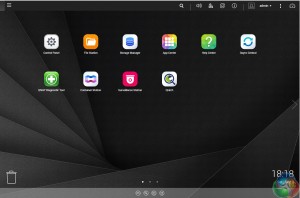
We used the latest 4.3 version of QNAP's QTS OS to set up the TVS-473-16G. QNAP have really gone to town on this version with a whole host of revamps and improvements, the most important of which is that the OS now uses a 64-bit system architecture. The control panel has been revamped and there is now a more streamlined approach to system warnings and error notifications (including that voice alert).
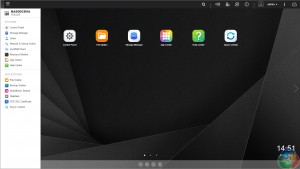
QTS is a graphically-rich OS with the major apps appearing as icons on the main page. Clicking on the ‘hamburger‘ menu icon at the top left-hand side of the screen drops down a very useful side menu. Clicking the icon on the top right of the screen activates the Dashboard page which gives a snapshot of what’s happening with the NAS.
The Control panel has been revamped to make it easier to access all the various functions of the NAS which are neatly divided into groups; System Settings, Privilege Settings, Network Services etc.
Storage Manager gives you complete control over setting up drives and volumes, in addition to showing how the capacity of the NAS is being used and warnings of potential failures. The Storage/Disks/VJBOD sub-menu displays individual drive information and health with a handy graphical display showing which drive is being interrogated.
App Center has over 160 apps to choose from covering everything from backups to home automation and pretty much everything in between.
QTS 4.3 Highlights
Backup Station
Photo Station
Video Station
Music Station
File Station
Download Station
App Center
HD Station – Use a QNAP NAS as a home theater center
Hybrid Backup Sync
Storage Manager
QNAP Snapshot Agent
Qcontactz – contact mamagenement
QNAP QvPC – use the NAS as a PC
QUSBCam2.2 – Surveillance tool
Plex Media Server
Qmedia
myQNAPcloud
QNAP Mobile Apps including
Qremote – Control HD Station with your mobile phone
Vmobile – Professional mobile surveillance app
Vcam – Turn your mobile device into an IP cam
Qmanager – Remote management for NAS
Qfile – Remote file access
Qnotes – Take and share notes
Qphoto – Photo sharing
Qget – Remotely manage download tasks
There are two ways of setting up a QNAP NAS either online by entering the Cloud key which is on the side of the unit or by using QNAP’s Qfinder Pro utility. Its then a matter of following the install wizard to get the NAS ready for use.
The default setup for the TVS-473-16G with four disks is RAID 5. It takes around 20 minutes to get the NAS set up and ready to use but obviously longer to get the disks synchronised. Once the NAS is set up, clicking on the NAS in the QFinder Pro brings up the log in screen.
One Touch
The One Touch button on the front bezel can be set up to either upload or download files/folders or backup the NAS to an external USB drive. In the Backup Station pages in the QTS you can set up exactly what you want the One Touch system to do.
QuickAccess
QuickAccess is a very clever idea. Using the USB QuickAccess port in the front bezel you can connect the TVS-473-16G to your PC via a USB cable to gain access to files and folders on the NAS (it shows up as a QuickAccess icon in Qfinder once connected). So should the network fail or you need to use the NAS in a location without wired Ethernet you can still get to your data – very neat.
The NAS unit is essentially being treated as a DAS.
HybridDesk Station
The HybridDesk Station is QNAP’s software that allows the NAS to be used as a home media player or a basic PC (via one of the HDMI ports). In this mode you don’t even have to fire up a PC to use the NAS. You have a choice of how you want to install the apps that are part of the HybridDisk Station; you can either cherry-pick them from a list and manually install them or simply press the install button and the NAS will load all the appropriate apps.
Plug a USB mouse and a keyboard into the NAS and away you go. Alternatively, you could you use the bundled RM-IR004 remote control.
Testing Methodology
Our review sample TVS-473-16G came with four 2TB Seagate NAS (ST2000VN00-1HJ164) drives pre-installed so that's what we used to test the device. The drive came pre-configured in a RAID 5 array but we also tested the unit in all the other RAID arrays it supports; 0,1, 6 and 10.
Software:
Atto Disk Benchmark.
CrystalMark 3.0.3.
IOMeter.
Intel NASPT.
To test real life file/folder performance we use a number of different file/folder combinations to test the read and write performance of the NAS device. Using the FastCopy utility to get a MB/s and time taken for each transfer, the data is written from and read back to a 240GB SSD.
60GB Steam folder: 29,521 files.
50GB Files folder: 28,523 files.
12GB Movie folder: 24 files – mix of Blu-ray and 4K files.
10GB Photo folder: 621 files – mix of .png, .raw and .jpeg images.
10GB Audio folder: 1,483 files – mix of .mp3 and .flac files.
Crystalmark is a useful benchmark to measure theoretical performance levels of hard drives and SSD’s. We are using V3.0.3.

The TVS-473-16G shows a consistent level of write performance across all arrays when dealing with small everyday files. Read performance when in a RAID 6 array did fall away a little.
The ATTO Disk Benchmark performance measurement tool is compatible with Microsoft Windows. Measure your storage systems performance with various transfer sizes and test lengths for reads and writes. Several options are available to customize your performance measurement including queue depth, overlapped I/O and even a comparison mode with the option to run continuously.
Use ATTO Disk Benchmark to test any manufacturers RAID controllers, storage controllers, host adapters, hard drives and SSD drives and notice that ATTO products will consistently provide the highest level of performance to your storage.

The TVS-473-16G is a very consistent performer as can be seen by the ATTO benchmark results. Regardless of which type of RAID array it was using it never deviated from a speed of 118 or 119MB/s.
Intel’s NASPT (NAS Performance Toolkit ) is a benchmark tool designed to enable direct measurement of home network attached storage (NAS) performance. NASPT uses a set of real world workload traces (high definition video playback and recording, video rendering/content creation and office productivity) gathered from typical digital home applications to emulate the behaviour of an actual application.
We’ve used some of the video and office apps results to highlight a NAS device’s performance.
HD Video Playback
This trace represents the playback of a 1.3GB HD video file at 720p using Windows Media Player. The files are accessed sequentially with 256kB user level reads.
4x HD Playback
This trace is built from four copies of the Video Playback test with around 11% sequential accesses.
HD Video Record
Trace writes an 720p MPEG-2 video file to the NAS. The single 1.6GB file is written sequentially using 256kB accesses.
HD Playback and Record
Tests the NAS with simultaneous reads and writes of a 1GB HD Video file in the 720p format.
Content Creation
This trace simulates the creation of a video file using both video and photo editing software using a mix of file types and sizes. 90% of the operations are writes to the NAS with around 40% of these being sequential.
Office Productivity
A trace of typical workday operations. 2.8GB of data made up of 600 files of varying lengths is divided equally between read and writes. 80% of the accesses are sequential.
Photo Album
This simulates the opening and viewing of 169 photos (aprrox 1.2GB). It tests how the NAS deals with a multitude of small files.
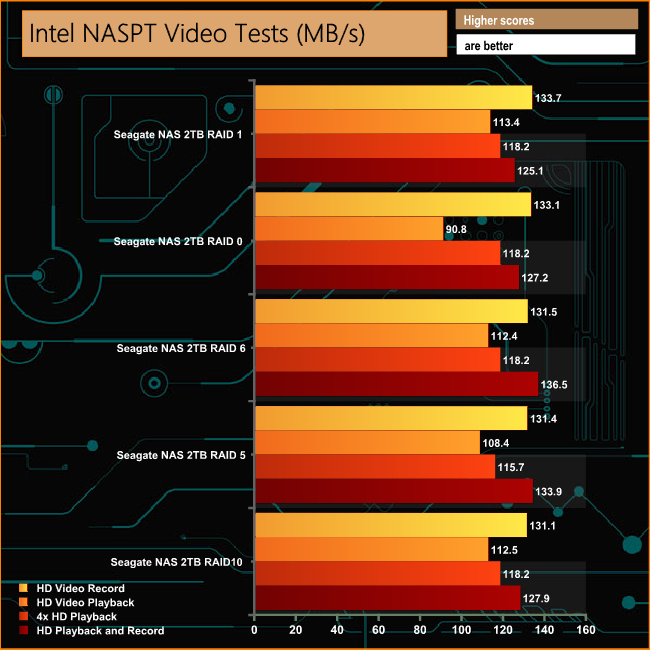
The TVS-473-16G showed solid performance in the NASPT Video tests regardless of which RAID array was being tested. The only time it didn't produce over 100MB/s performance was in the HD VideoPlayback test when in a RAID 0 array when speed dropped to 90.8MB/s.
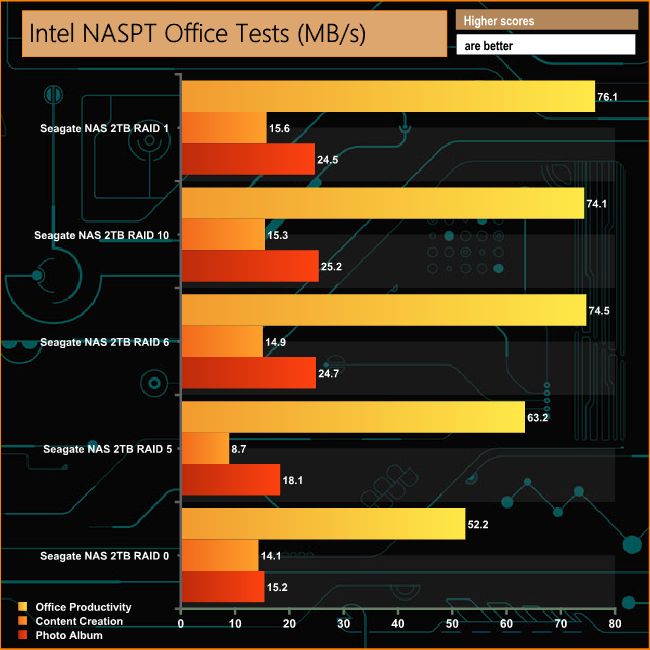
Once again good performance across all types of array, apart that is from the Content Creation test in a RAID 5 configuration where the performance dropped dramatically to just 8.7MB/s.
IOMeter is another open source synthetic benchmarking tool which is able to simulate the various loads placed on hard drive and solid state drive technology.
We set IOmeter up (as shown above) to test both backup and restore performance on a 100GB partition.
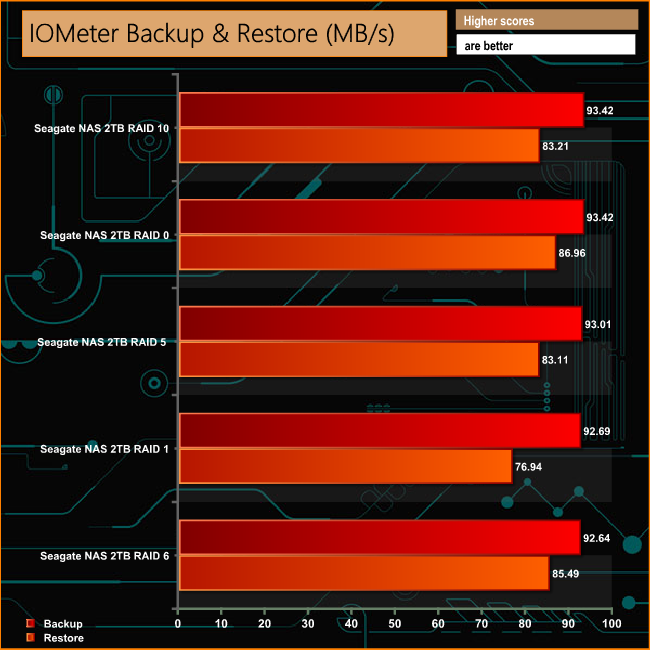
The NAS showed a good level of performance in all arrays in both reads and writes when dealing with the 100GB file we used in this test. There was a very slight drop off in performance in RAID 1 when writing the data back to the NAS.
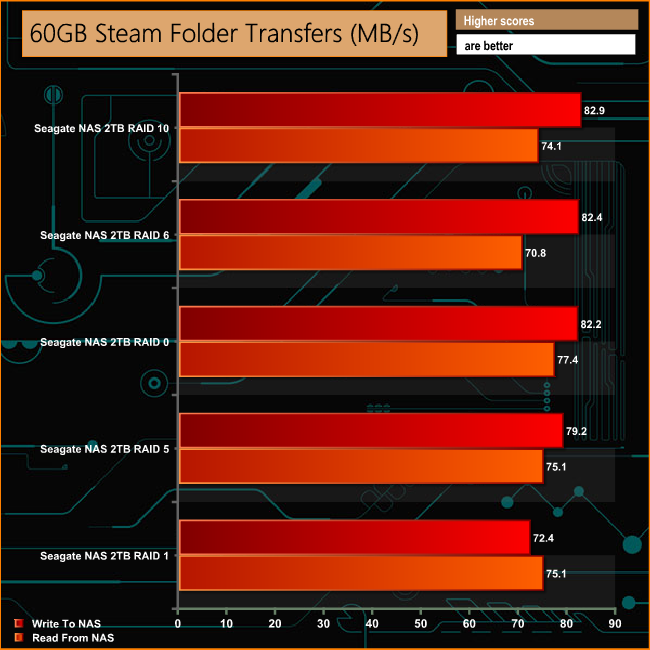
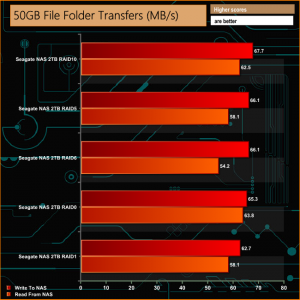
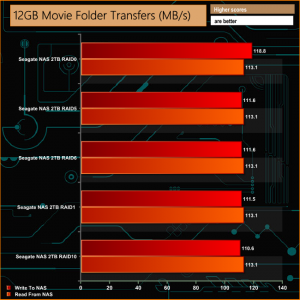
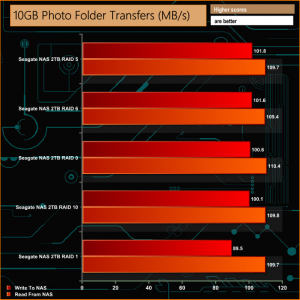
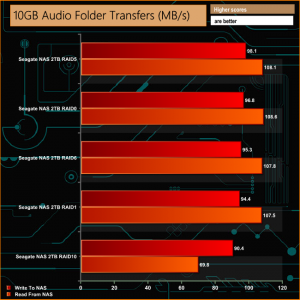
The TVS-473-16G had no difficulties when dealing with the real life test folder tests showing a good deal of consistency across the range of arrays tested.
We tested the peak power consumption of a NAS at the wall during a run of CrystalDiskMark 5.0.2 as this version of the benchmark runs the read and write benchmark suites separately so its easier to monitor what power the device is using during each function.
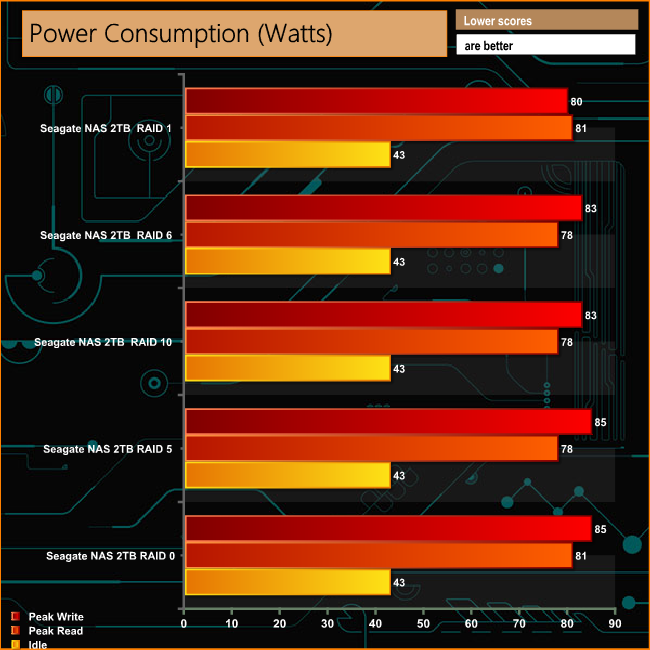
Power consumption with the four Seagate 2TB NAS drives ranged between 80W and 85W for writes and 78W – 81W for reads but this is a worse case scenario as in daily use it would be rare for the unit to be pushed as hard as it does during benchmarking.
NAS drives have been more than just a depository for files for some time with manufacturers adding more and more features, turning them over time from mere storage devices to powerful multifunctional devices. With the TVS-473, QNAP has given us a strong hint as to where NAS design and function might be heading in the not too distant future.
The feature list reads more like a desktop PC than a storage vehicle; powerful quad cored SoC with decent integrated graphics, four DDR4 memory slots, support for SSD caching, M.2 SSD support, hardware-assisted 4K video decoding and encoding and by using the PCIe slots, 1oGbE network connectivity.
QNAP quote throughput figures on their website for the TVS-473 as up to a massive 1035MB/s for reads and 644MB/s for writes for a 10GB file transfer, but as they say the devil is in the detail. These figures are achieved by using a 10Gbe NIC and four SSDs. Using the four Seagate drives that came pre-installed and a single NIC, the NAS showed a very consistent level of performance in the ATTO benchmark never deviating from the 118-119MB/s mark for reads and writes regardless of the array the drives were built in.
The latest 4.3 version of QNAP's QTS OS improves on what was already one of the better NAS operating systems around. The most important of these improvements is a move to a 64-bit architecture but there is a 64-bit compatibility tool you can download from the QNAP website if you are running 32-bit applications and are not sure if they are supported.
Amongst other tweaks and refreshes, the Control Panel has had a revamp so it now provides more information and is easier to use, as is the Resource Manager which has had a polish so now it too is easier to navigate around to get the information you require. System warnings and other alerts are now available without logging into the NAS via a variety of means; SMS, email, browser pop-ups and voice alerts.
We found the QNAP TVS-473-16G configured with four Seagate 2TB NAS disks as QNAP sent it to us for £1,568.40 inc VAT at Span.com HERE.
Discuss on our Facebook page, over HERE.
Pros
- Hardware specification
- QTS OS
- Futureproof potential
Cons
- Expensive
Kitguru says: The QNAP TVS-473 is a powerful NAS for either home or small business and with its PCI-e slots and M.2 SSD support it also offers a good degree of future proofing in both storage and connectivity functions.
 KitGuru KitGuru.net – Tech News | Hardware News | Hardware Reviews | IOS | Mobile | Gaming | Graphics Cards
KitGuru KitGuru.net – Tech News | Hardware News | Hardware Reviews | IOS | Mobile | Gaming | Graphics Cards


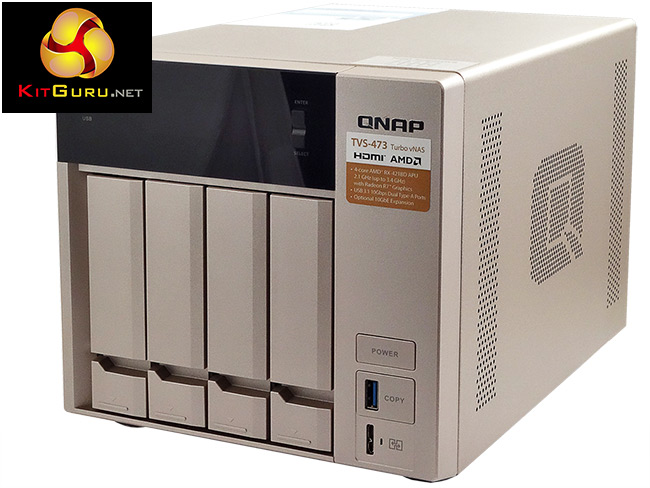
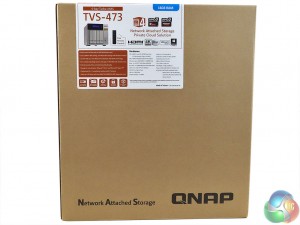

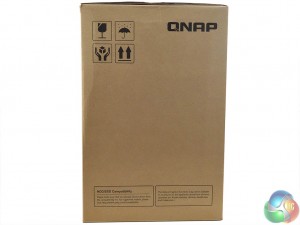
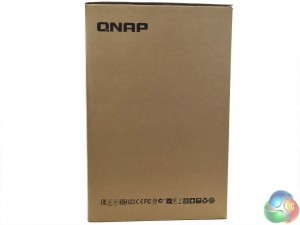
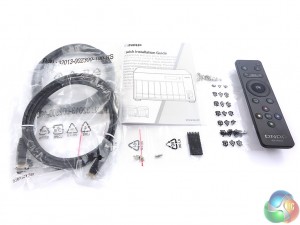
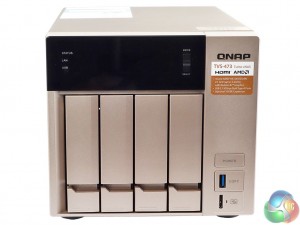
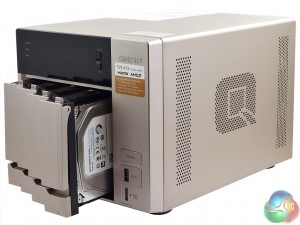
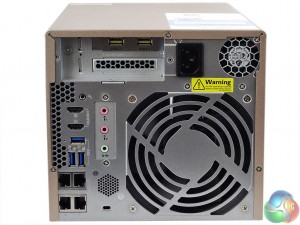
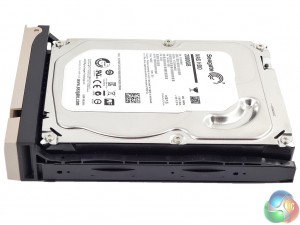
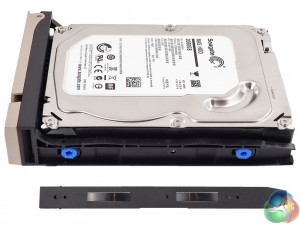
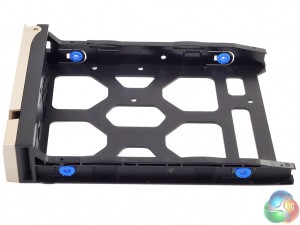
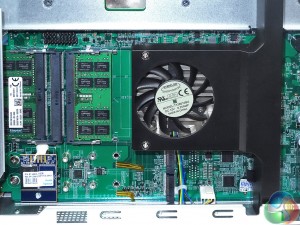
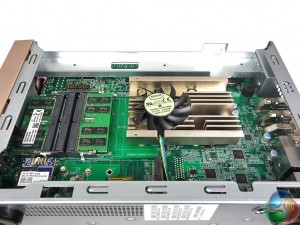
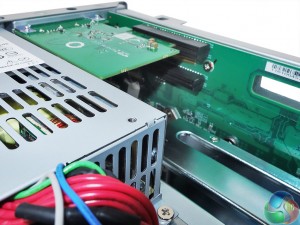
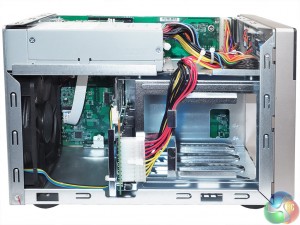
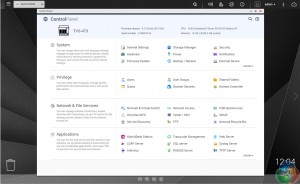
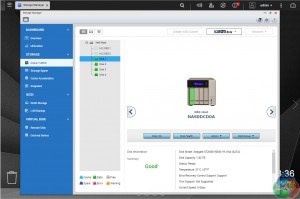
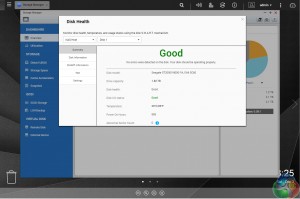
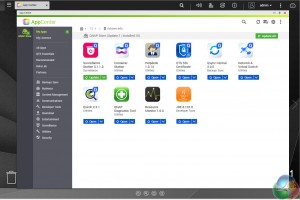
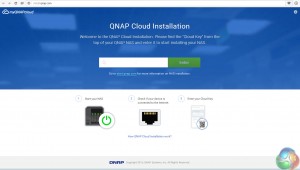
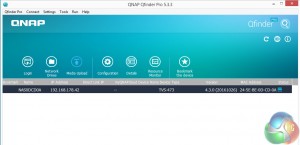
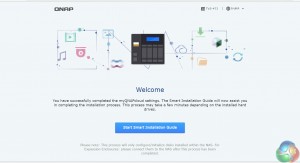
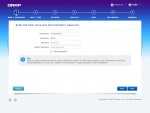
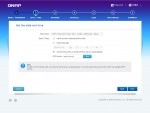
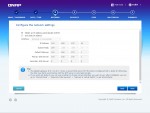
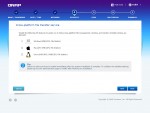
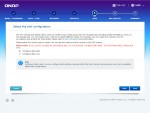
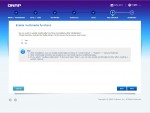
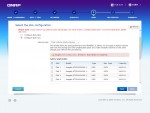
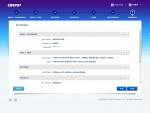
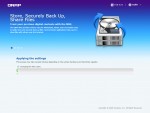


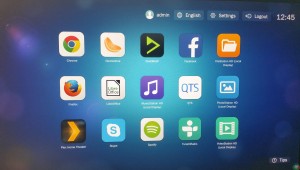
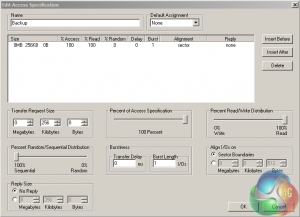
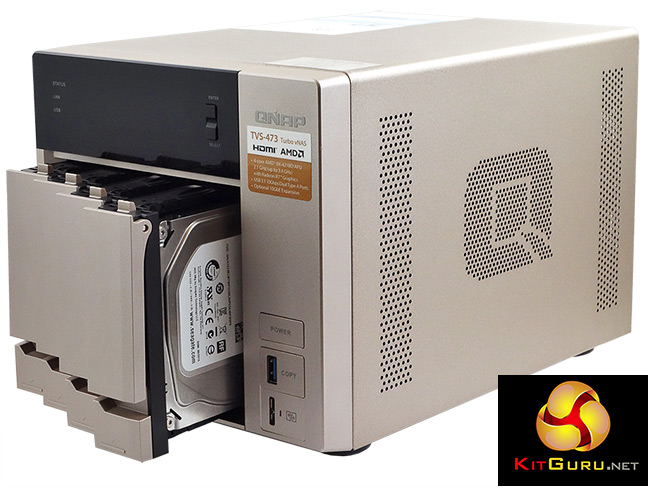

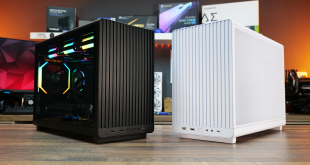
Scrolled down to the comments expecting to see the chap who trawls the internet to post his negative story on QNAP C&P’ing his woe but he’s not made it yet.
*waits*
I feel like I’ve been waiting forever for a proper review of this device—so it’s great to see your review (and that you rate it!) 🙂
I really like the TVS-x82 series with it’s dedicated SSD (and M.2) slots, but couldn’t justify the price. Although still expensive, at least this is somewhat cheaper yet still has M.2 slots for caching etc. Nice compromise, imo. The R7 graphics are also interesting.
well I have this and I’m getting only 33mb transfer speed
What is the frame rate of the the graphics chipset? I know the TVS-471 was 30 FPS so I am hoping this is markedly better and therefore better suited to also serve as a media center on top of separately being a media server.
Also which memory configuration did you end up getting, 8 GB, 16 GB, or 64 GB? Does QNAP take the cheap way out and populate all 4 SODIMM slots with the smallest possible RAM modules possible for each system memory size which thereby forces you to replace all four SODIMMs when you come around and upgrade them? Or, are they civilized and only use two of the four available SODIMM slots so you can simply add 2 more SODIMMs without wasting any RAM?
Using the built in File Station app, I got 100+mb rates from NAS to NAS.